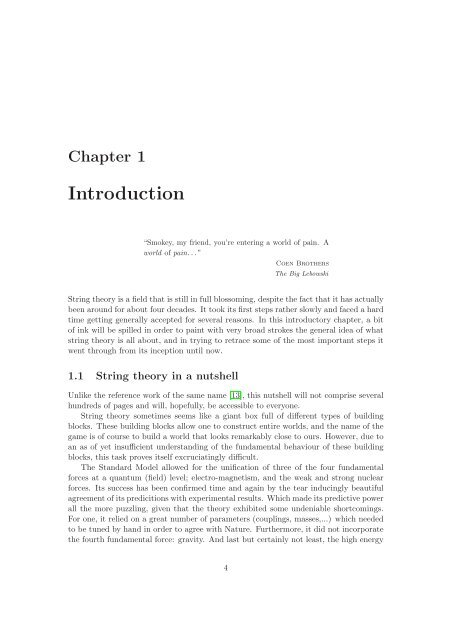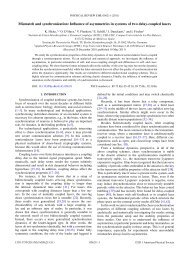DBI Analysis of Open String Bound States on Non-compact D-branes
DBI Analysis of Open String Bound States on Non-compact D-branes
DBI Analysis of Open String Bound States on Non-compact D-branes
You also want an ePaper? Increase the reach of your titles
YUMPU automatically turns print PDFs into web optimized ePapers that Google loves.
Chapter 1Introducti<strong>on</strong>“Smokey, my friend, you’re entering a world <str<strong>on</strong>g>of</str<strong>on</strong>g> pain. Aworld <str<strong>on</strong>g>of</str<strong>on</strong>g> pain...”Coen BrothersThe Big Lebowski<str<strong>on</strong>g>String</str<strong>on</strong>g> theory is a field that is still in full blossoming, despite the fact that it has actuallybeen around for about four decades. It took its first steps rather slowly and faced a hardtime getting generally accepted for several reas<strong>on</strong>s. In this introductory chapter, a bit<str<strong>on</strong>g>of</str<strong>on</strong>g> ink will be spilled in order to paint with very broad strokes the general idea <str<strong>on</strong>g>of</str<strong>on</strong>g> whatstring theory is all about, and in trying to retrace some <str<strong>on</strong>g>of</str<strong>on</strong>g> the most important steps itwent through from its incepti<strong>on</strong> until now.1.1 <str<strong>on</strong>g>String</str<strong>on</strong>g> theory in a nutshellUnlike the reference work <str<strong>on</strong>g>of</str<strong>on</strong>g> the same name [13], this nutshell will not comprise severalhundreds <str<strong>on</strong>g>of</str<strong>on</strong>g> pages and will, hopefully, be accessible to every<strong>on</strong>e.<str<strong>on</strong>g>String</str<strong>on</strong>g> theory sometimes seems like a giant box full <str<strong>on</strong>g>of</str<strong>on</strong>g> different types <str<strong>on</strong>g>of</str<strong>on</strong>g> buildingblocks. These building blocks allow <strong>on</strong>e to c<strong>on</strong>struct entire worlds, and the name <str<strong>on</strong>g>of</str<strong>on</strong>g> thegame is <str<strong>on</strong>g>of</str<strong>on</strong>g> course to build a world that looks remarkably close to ours. However, due toan as <str<strong>on</strong>g>of</str<strong>on</strong>g> yet insufficient understanding <str<strong>on</strong>g>of</str<strong>on</strong>g> the fundamental behaviour <str<strong>on</strong>g>of</str<strong>on</strong>g> these buildingblocks, this task proves itself excruciatingly difficult.The Standard Model allowed for the unificati<strong>on</strong> <str<strong>on</strong>g>of</str<strong>on</strong>g> three <str<strong>on</strong>g>of</str<strong>on</strong>g> the four fundamentalforces at a quantum (field) level; electro-magnetism, and the weak and str<strong>on</strong>g nuclearforces. Its success has been c<strong>on</strong>firmed time and again by the tear inducingly beautifulagreement <str<strong>on</strong>g>of</str<strong>on</strong>g> its prediciti<strong>on</strong>s with experimental results. Which made its predictive powerall the more puzzling, given that the theory exhibited some undeniable shortcomings.For <strong>on</strong>e, it relied <strong>on</strong> a great number <str<strong>on</strong>g>of</str<strong>on</strong>g> parameters (couplings, masses,...) which neededto be tuned by hand in order to agree with Nature. Furthermore, it did not incorporatethe fourth fundamental force: gravity. And last but certainly not least, the high energy4
















